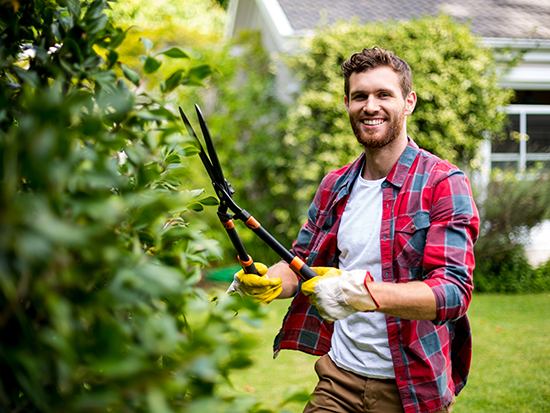Media contact: Anna Jones
 Learn how to prevent and treat some common types of outdoor injuries.Outdoor work can wreak havoc on those who do not take steps to protect themselves. Experts in the University of Alabama at Birmingham Marnix E. Heersink School of Medicine say there are several ways to prevent and treat common yardwork and outdoor injuries.
Learn how to prevent and treat some common types of outdoor injuries.Outdoor work can wreak havoc on those who do not take steps to protect themselves. Experts in the University of Alabama at Birmingham Marnix E. Heersink School of Medicine say there are several ways to prevent and treat common yardwork and outdoor injuries.
Pulled Muscles and Joint Pain
UAB Department of Orthopaedic Surgery Sports Medicine Section Chief Amit Momaya, M.D., suggests making small changes to optimize muscle and joint functionality.
“Be sure to warm up the muscles and joints before working. Dynamic stretching is typically recommended over static stretching before activity,” Momaya said. “When bending down to garden and perform yardwork, be sure to hinge at your hips and not at the back. This can help decrease back pain from such activities. If you are sitting on your knees for a long period of time, be sure to use knee pads or cushions under your knees. This helps to prevent knee bursitis. Also, alternate which arms you use to perform activities so one side of the body does not get overused. For example, when raking, switch arms intermittently.”
Sunburn
People are more likely to develop skin cancer, sunburn and premature skin aging if they do not protect their skin from the sun, says UAB Department of Dermatology Assistant Professor Lauren Kole, M.D.
She recommends using sunscreen, shade and proper clothing to prevent sunburn.
“The sun’s rays are the strongest between 10 a.m. and 2 p.m., so avoiding extended outdoor activities during this time can be helpful,” Kole said. “Wear a lightweight and long-sleeved shirt, long pants, a wide-brimmed hat, and sunglasses with UV protection. Look for clothes with UPF (ultraviolet protection factor). Apply a broad-spectrum, water-resistant sunscreen with an SPF of 30 or higher to all skin not covered by clothing. Always reapply every two hours or after swimming or sweating.”
The hot Alabama sun can cause more than just sunburn. Learn how to prevent, recognize and treat heat illnesses such as heat exhaustion and heat stroke here.
If sunburn occurs, Kole says to stay hydrated, use aloe vera-based topicals and rinse the spot with cool water.
Insect Bites and Stings
Kole recommends applying 20 percent-30 percent DEET insect repellant to bare skin and clothes and covering limbs with long pants, long-sleeved shirts and close-toed shoes to avoid unwelcome bites, stings and rashes from the outdoors.
“If you end up getting a bite or sting, do not scratch or pick at the affected area,” she said. “If stung, remove the stinger, wash the area with soap and water, apply an ice pack to reduce swelling, and consider taking an over-the-counter pain medication if needed. For itchy bites, poison ivy or poison oak, you may apply an OTC hydrocortisone cream or an anti-itch lotion.”
Snakes are more active as the weather warms up. If bitten by a snake, contact the Alabama Poison Control Center at 1-800-222-1222. In addition, the new UAB Comprehensive Snakebite Program is a good resource to use following a snake bite.
Lawn Chemical Burns
To treat burns from lawn chemicals, Kole says to use soap and water to clean exposed skin and contact the Alabama Poison Control Center at 1-800-222-1222.
Cuts and Splinters
Wearing protective clothing and gloves can help prevent cuts and splinters, Kole says. If a cut or splinter does occur, Kole says to use clean hands to wash the affected area with water and soap, remove any splinters with a small, clean needle or tweezers, put on Vaseline, and cover with a bandage.
 UAB Callahan Eye Hospital Emergency and Eye Trauma Department provides the only 24/7 emergency department totally dedicated to eye emergencies and eye trauma in Alabama and one of only two in the nation.Eye Injuries
UAB Callahan Eye Hospital Emergency and Eye Trauma Department provides the only 24/7 emergency department totally dedicated to eye emergencies and eye trauma in Alabama and one of only two in the nation.Eye Injuries
Wearing proper eye protection is the most important step to take to prevent eye injuries from equipment used outdoors, says UAB Department of Ophthalmology and Visual Sciences Clinical Instructor Carrie Smith, O.D.
“Injuries from power tools or yard equipment are one of the most common causes of eye injury I see in my clinic,” Smith said. “Safety goggles or safety glasses with side shields that are ANSI Z87.1-compliant are the best way to protect your eyes from injury from high-velocity debris that can be kicked up when using these machines. Avoid relying just on prescription eyeglasses and sunglasses because they don’t provide enough eye protection.”
Smith also says to avoid wearing contacts during activities involving airborne dust or debris as eye irritation, abrasion or infection can result when these particles get caught under contacts.
If a small object gets in the eye, Smith says first make sure the eye does not have a contact lens in it, then use clean water to flush the eye. Do not rub or touch the eye in an effort to remove the object. She recommends scheduling an appointment with a provider at the UAB Callahan Eye Hospital Clinic – UAB Campus as soon as possible if the eye is still red and irritated after 24 hours.
In some situations, Smith says emergency treatment is necessary.
“If you experience an eye injury resulting in severe pain, blurred vision or bleeding or you believe something may have penetrated the eye, it’s best to go to the UAB Callahan Eye Hospital Emergency Department immediately for care,” Smith said. “If you get a corrosive chemical in your eye, make sure to flush with clean water for at least 20 minutes and seek emergency eye care immediately.”
